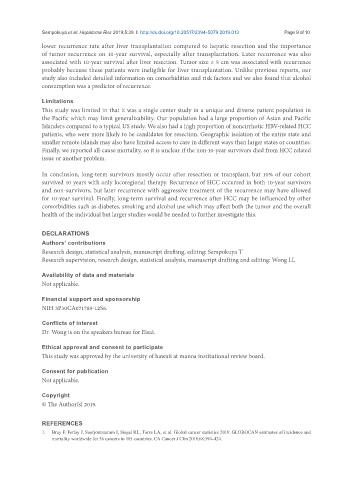Page 393 - Read Online
P. 393
Sempokuya et al. Hepatoma Res 2019;5:38 I http://dx.doi.org/10.20517/2394-5079.2019.013 Page 9 of 10
lower recurrence rate after liver transplantation compared to hepatic resection and the importance
of tumor recurrence on 10-year survival, especially after transplantation. Later recurrence was also
associated with 10-year survival after liver resection. Tumor size ≥ 5 cm was associated with recurrence
probably because these patients were ineligible for liver transplantation. Unlike previous reports, our
study also included detailed information on comorbidities and risk factors and we also found that alcohol
consumption was a predictor of recurrence.
Limitations
This study was limited in that it was a single center study in a unique and diverse patient population in
the Pacific which may limit generalizability. Our population had a large proportion of Asian and Pacific
Islanders compared to a typical US study. We also had a high proportion of noncirrhotic HBV-related HCC
patients, who were more likely to be candidates for resection. Geographic isolation of the entire state and
smaller remote islands may also have limited access to care in different ways than larger states or countries.
Finally, we reported all-cause mortality, so it is unclear if the non-10-year survivors died from HCC related
issue or another problem.
In conclusion, long-term survivors mostly occur after resection or transplant, but 10% of our cohort
survived 10 years with only locoregional therapy. Recurrence of HCC occurred in both 10-year survivors
and non-survivors, but later recurrence with aggressive treatment of the recurrence may have allowed
for 10-year survival. Finally, long-term survival and recurrence after HCC may be influenced by other
comorbidities such as diabetes, smoking and alcohol use which may affect both the tumor and the overall
health of the individual but larger studies would be needed to further investigate this.
DECLARATIONS
Authors’ contributions
Research design, statistical analysis, manuscript drafting, editing: Sempokuya T
Research supervision, research design, statistical analysis, manuscript drafting and editing: Wong LL
Availability of data and materials
Not applicable.
Financial support and sponsorship
NIH 3P30CA071789-12S6.
Conflicts of interest
Dr. Wong is on the speakers bureau for Eisai.
Ethical approval and consent to participate
This study was approved by the university of hawaii at manoa institutional review board.
Consent for publication
Not applicable.
Copyright
© The Author(s) 2019.
REFERENCES
1. Bray F, Ferlay J, Soerjomataram I, Siegel RL, Torre LA, et al. Global cancer statistics 2018: GLOBOCAN estimates of incidence and
mortality worldwide for 36 cancers in 185 countries. CA Cancer J Clin 2018;68:394-424.

